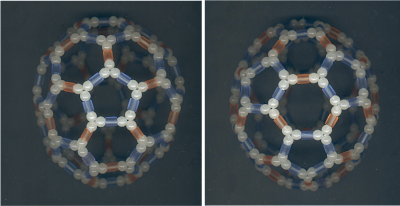I just made two more dodecahedral C20 in order to make my point clearer. The model in the left of the following figure is made from the standard spherical beads. Due to the hard-sphere repulsions among nearest beads, the resulting structure is quite stable even under moderate external pressure.
To some people, particularly some organic chemists, the most confusing part of our beaded representation of fullerenes is that the beads in the model stand for bonds instead of atoms as commonly used in stick-and-ball models. Thus we need thirty beads to make a C20. Since most people are used to the concept that any spherical object in a molecular model must correspond to an atom, thus our beaded models based on spherical beads may cause some confusion. The simplest way to solve this problem is that we should use beads with large aspect ratio to build our physical models. The model in the right of the following figure is constructed with this kind of beads. The beads as chemical bonds can be seen clearly. Unfortunately, this kind of beads cannot mimic repulsions among sp2 orbitals as good as spherical beads.
An effective strategy to improve this problem is based on the type of beading introduced in previous message.
















